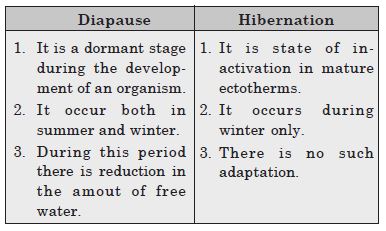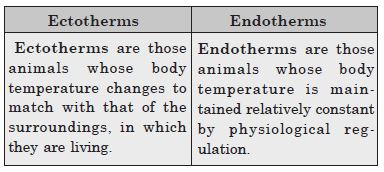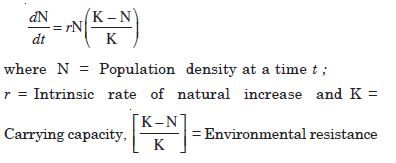Question 1:
How is diapause different from hibernation?
Answer:
Differences between diapause and hibernation.

Question 2:
If a marine fish is placed in a fresh water aquarium, will the fish be able to survive ? Why or why not?
Answer:
The marine fish cannot live in fresh water because of the osmotic problems, it would face
death.
Rapid endosmosis occurs which increases blood volume and blood pressure that causes death of
fish.
Question 3:
Define phenotypic adaptation. Give one example.
Answer:
Phenotypic adaptation involves non-genetic changes in individuals such as physiological
modifications, acclimatization or behavioural changes. Some organisms possess adaptations
that are phenotypic, which
allow them to respond quickly to a stressful situation.
Example. If a person had ever been to any high altitude place (Rohtang pass near
Manali or Mansrover in Tibet), he or she must have altitude sickness because body does not
get enough oxygen at such a height and
protect themselves from atmospheric hypoxia.
Question 4:
Most living organisms cannot survive at temperature at about 45°C. How are some microbes able to live in habitats with temperatures exceeding 100°C?
Answer:
1. Some microorganisms of hot springs and
vents can survive at high temperature.
2. They have minimum amount of free water in their bodies. Removal of water provides
resistance to high temperature.
3. They also have heat tolerant molecules such as branched chain lipids in their cell walls
that reduces fluidity and
4. They have thermal resistant enzymes.
Question 5:
List the attributes that populations possess but not the individuals.
Answer:
(i) Natality
(ii) Mortality
(iii) Growth forms
(iv) Population density
(v) Population dispersion
(vi) Population age distribution
Question 6:
If the population growing exponentially doubles in size in 3 years, what is the intrinsic rate of increase (r) of the population?
Answer:
The intrinsic rate of increase (r) of such a population will be towards maximum.
Intrinsic rate of increase (r) of population can be calculated by applying following
equation :

Question 7:
Name important defence mechanisms in plants against herbivory.
Answer:
Defence mechanism of plants against herbivorous animals
1. Formation of thick cuticle on their leaf surface.
2. Formation of leaf spines e.g. leaf spines in Opuntia
3. Modification of leaves into thorns. e.g. Bougainvillea and Duranta
4. Development of spiny margins on leaves.
5. Development of sharp silicated edges in leaves.
6. Many plants produce and store toxic chemicals which cause discomforts to herbivores e.g.
cardiac glucoside by Calotropis, Nicotine by tobacoo.
Question 8:
An orchid plant is growing on the branch of mango tree. How do you describe this interaction between the orchid and the mango tree?
Answer:
The orchid grows as an epiphyte on branch of mango tree. The interaction between orchid and the mango tree is termed commensalism where in orchid derives benefit of interaction while mango tree is not affected.
Question 9:
What is the ecological principle behind the biological control method of managing with pest insect?
Answer:
Predation is the means of biological control to manage pest insects where predators prey upon pests and regulate their numbers in the habitat. Gambusia fish preys upon larvae of mosquito thus regulate the number of insects.
Question 10:
What is the ecological principle behind the biological control method of managing with pest insect?
Answer:
Predation is the means of biological control to manage pest insects where predators prey upon pests and regulate their numbers in the habitat. Gambusia fish preys upon larvae of mosquito thus regulate the number of insects.
Question 11:
Distinguish between the following:
(a) Hiberation and aestivation
(b) Ectotherms and endotherms.
Answer:
(a) Differences between hibernation and aestivation

(b) Differences between ectotherms and endotherms.

Question 12:
Write short notes on adaptations of desert plants and animals.
Answer:
Adaptations of desert plants and animals. 1. Adaptations of desert animals.
1. Animals faced with water scarcity as found in arid or desert areas, show two types of
adaptations, reducing water loss and ability to tolerate arid conditions. Kangaroo/Desert
Rat seldom drinks water. It has a thick coat to minimise evaporative desiccation. The animal
seldom comes out of its comparatively humid and cool burrow during the day time. 90% of its
water requirement is met from metabolic water (water produced by respiratory breakdown)
while 10% is obtained from food.
2. Loss of water is minimised by producing nearly solid urine and faeces.
3. Spiny skin and highly cornified in Phrynosoma (horned toad) and Maloch horridus.
2. Adaptations of desert plants. 1. Plants have thick cuticle, succulent organs where water
and mucilage are stored.
2. Stomata are sunken.
3. They have well developed branched root system.
4. They possess waxy coating on surface.
5. Crassilucean pathway of photosynthesis.
6. They are C4 plants.
Question 13:
Write short notes on adaptations of plants to water scarcity.
Answer:
Adaptations of plants to water scarcities. They are called xerophytes. The above mentioned adaptation of plants are applicable (see part (a).
Question 14:
Write short notes on behavioural adaptations in animals.
Answer:
Behavioural adaptations in animals. (i) Hibernation (ii) Aestivation (iii) Periodic Activity (iv) Camouflage migration
Question 15:
Write short notes on importance of light to plants.
Answer:
Importance of light to plants. (1) Source of energy (2) Photoperiodism (3) Pigmentation (4) Daily rhythm (5) Plant movements and (6) Growth.
Question 15:
Write short notes on effect of temperature or water scarcity and the adaptation of animals.
Answer:
Effect of temperature or water scarcity and adaptation of animals. As discussed in (c) and reducing loss of water from body, and ability to tolerate arid condition.
Question 16:
List the various abiotic environmental factors.
Answer:
(i) Climatic factors e.g.
(c) Humidity
(e) Rainfall
(g) Atmospheric gases.
(ii) Edaphic factors e.g
(a) Soil type
(b) Topography of soil
(c) pH of soil.
(b) Temperature
(d) Wind
(f) Water
Question 17:
Give an example for:
(a) An endothermic animal.
(b) An ectothermic animal.
(c) An organism of benthic zone.
Answer:
(a) Birds and mammals;
(b) Amphibians and reptiles ;
(c) Bacteria, sponges, corals, star fishes, etc.
Question 18:
Define population and community.
Answer:
Population. A population is a unit of biotic community made up of near
permanent group of interbreeding individuals of a species found in a geographical area or
space at a particular time.
Community. It is a grouping of different but independent and interacting
populations of different species which live in a specific locality, e.g., pond community.
Question 19:
Define the following terms and give one example for each:
(a) Commensalism
(b) Parasitism
(c) Camouflage
(d) Mutualism
(e) Interspecific Competition
(f) Symbiosis (g) Mimicry.
Answer:
(a) Commensalism is the relationship of two species of which the smaller one is benefited and
the larger one is unaffected. Example: sucker fish and shark.
(b) Parasitism is an association of two species in which the smaller species is benefited
and the larger one is harmed. Example: Tapeworm in human intestine.
(c) Camouflage. It is the ability to blend with the surroundings or background. It is
difficult to distinguish leaf insect from the surroundings.
(d) Mutualism. It is an association of two species both of which are benefited but cannot
live separately.
Example: Termites and flagellates.
(e) Interspecific competition. Interactions among the species of a community are based on
modes of obtaining food, shelter and habits. Interactions between two species may be
positive, such as
scavenging, commensalism, protocooperation, mutualism and plant-animal interdependent, or
negative, such as amensalism, competition, parasitism and predation.
(f) Symbiosis. It is the relationship between two individuals where both partners are
benefited. Following are the examples of symbiosis. The Rhizobium bacteria present in the
leguminous plant roots is an example of symbiosis. Bacteria live in the roots in the form of
nodules and avail carbohydrate and other food substances. In exchange bacteria fix the
nitrogen present in the atmosphere and makes it useful
for plants.
(g) Mimicry. It is phenomenon in which a living organism modifies its form, appearance,
structure or behaviour and looks like another living organism or some inanimate (non-living)
object so as to defend from
its predators, or to increase the chances of capturing the prey.
Question 20:
With the help of suitable diagram describe the logistic population growth curve.
Answer:
Logistic population growth curve.Unlimited resources result in exponential growth. Many
countries have realized this fact and introduced various restraints to limit human
population growth. In nature, a given habitat has enough resources to support a maximum
possible number, beyond which no further growth is possible. This limit is called as
carrying capacity (K) for that species in that habitat.
A population growing in a habitat with limited resources shows initially a lag phase,
followed by phases of increase and decrease and finally the population density reaches the
carrying capacity. A plot of N in relation to time (t) results in a sigmoid curve. This type
of population growth is called Verhulst-Pearl Logistic Growth as explained by the following
equation:


Since resources for growth for most animal populations become limiting sooner or later, the
logistic growth model is concerned a more realistic one.
Question 21:
Select the statement which explain best parasitism:
Answer:
One organism is benefited, other is affected.
Question 21:
List any three important characteristics of a population and explain.
Answer:
Three important characteristics of a population are:
(i) Population size and population density
(ii) Birth or natality rate
(iii) Death or mortality rate.
(i) Population size. The size of population keeps changing with time depending on the
factors like:
(i) Food availability
(ii) Weather
(iii) Predation pressure and
(iv) Competition.
The population density in a given habitat during a given period, changes due to four basic
processes namely (1) Natality, (2) Mortality, (3) Immigration and (4) Emigration.
While natality and immigration contribute to an increase in the size and density of a
population, mortality and emigration contribute to a decrease in them.
So the equation for population growth is:
Nt + 1 = Nt + [(B + I) – (D + E)],
where Nt = population density at time t.
B = birth rate.
I = Immigration.
D = death rate.
E = emigration.
If B + I is more than D – E, the population density increases.
If B + I is less than D – E, the population density decreases.
(ii) Birth or Natality rate. It is generally expressed as number or births per 1,000
individuals of a population per year. It increases the population size (total number of
individuals of a population) and population density.
Natal or Birth Rate

(iii) Death or Mortality rate. It is opposite of natality rate. It is commonly expressed as the
number of deaths per 1,000 individuals of a population per year.
Mortality (Death) Rate

